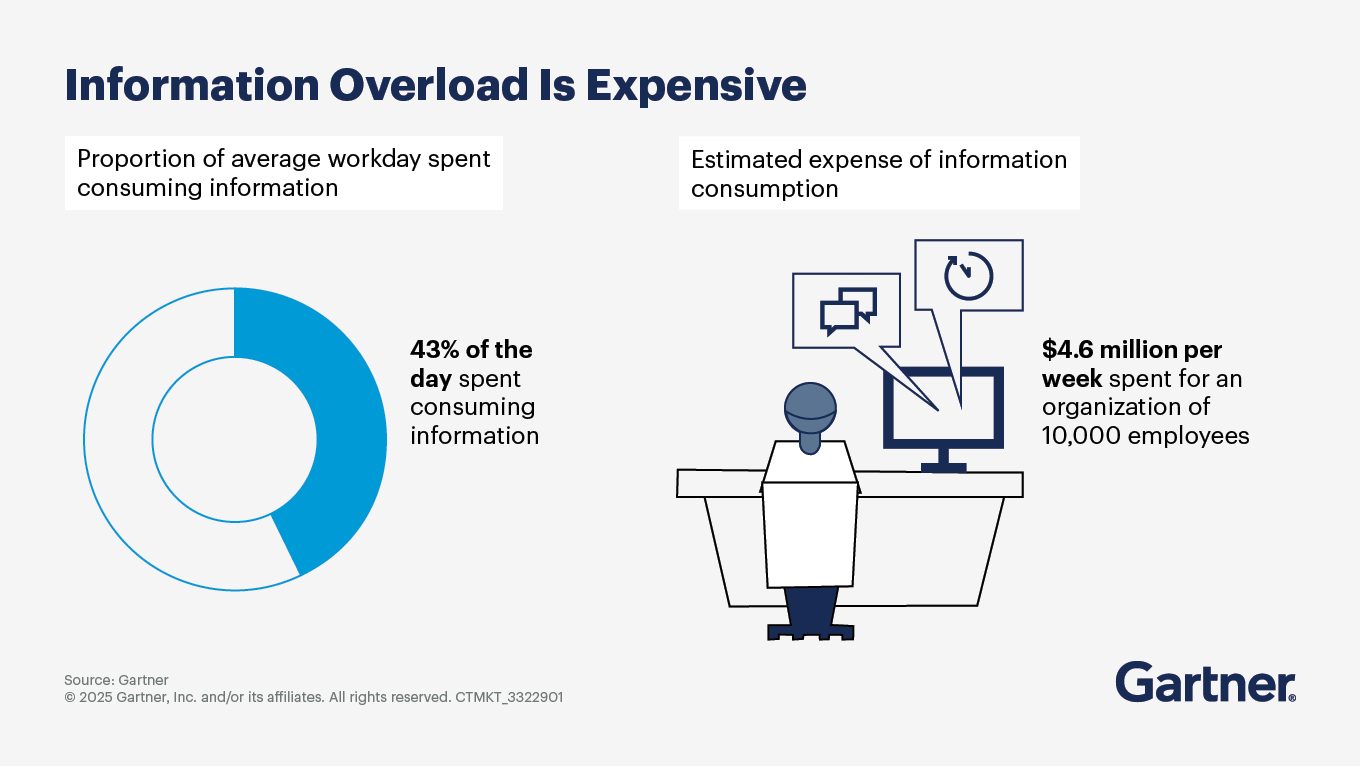Communications leaders face the challenge of reducing employees’ information overload while maintaining alignment and engagement.
- Gartner client? Log in for personalized search results.
Information Overload: Cut Through the Noise for More Effective Internal Communications
By Alexandra Earl | January 24, 2025
Information overload burdens communications leaders and employees
Everyone within an organization contributes to the problem of information overload, yet no single team or function can resolve it alone. New technologies and evolving behaviors only exacerbate things, as an increasing number of communication channels force employees to sift through a deluge of sources to uncover critical information. This both hampers productivity and poses strategic risks.
Although they cannot offer a foolproof solution on their own, communications leaders can guide the way by streamlining processes, prioritizing essential information and fostering a culture of clarity and efficiency.
Address information overload to increase organizational productivity
When it comes to information overload, communications leaders face three primary challenges: channel proliferation, information insecurity and capability mismatch. Addressing these is vital for organizational productivity.
The corporate costs of information overload
As you read this article, internal messages are traveling across your organization at breakneck speed on company apps, email and chat, impacting productivity, employee retention and strategic alignment. More than a quarter of employees and 38% of managers report feeling overwhelmed by excessive communication. This overload is linked to lower alignment with corporate strategy and a reduced intent to stay, as well as millions of dollars in lost productivity as employees spend valuable hours sifting through redundant or irrelevant messages.
Tackling the root causes of information overload is essential not just for boosting productivity and your bottom line, but also for creating an environment where employees feel engaged and valued.
Channel proliferation warrants a new strategy
The increase in communication channels, accelerated by shifts to remote and hybrid work, has led to increased message volume and complexity. Employees must navigate a maze of platforms, from global and local intranets to productivity tools, to access the information they need. This overwhelming array of channels demands a strategic rethink of channel management. Communications teams must clearly define each channel’s role within the portfolio to streamline information flow, ensuring that employees can efficiently find and use critical information.
Information insecurity: Balancing transparency and relevance
To navigate constant change and increased decision-making autonomy, employees crave more information. However, this demand creates a tension between transparency and relevance. Communications leaders must carefully redefine what constitutes “enough” information, so that employees receive the necessary context without being overwhelmed by unnecessary details. Striking this balance is particularly crucial for enabling lower-level leaders and frontline staff to make informed decisions and contribute effectively to the organization’s goals.
Evolve communications roles for newly needed capabilities
Employees’ ability to broadcast messages across the enterprise highlights a growing skills and capability mismatch within communications teams. Traditional communications skills like storytelling and writing, while still important, are no longer sufficient on their own. As peer-to-peer communications evolve, communications teams must also bring expertise in technology management, project management and governance.
Four strategies to combat information overload
To effectively tackle information overload, communications leaders should streamline processes, enhance relevance and foster collaboration using the following strategies:
Optimize channel management. Track channel volume and engagement to identify redundancies. Develop a streamlined channel strategy that prioritizes critical information and reduces noise to help employees focus on what truly matters.
Enhance information relevance. Conduct audits to understand employee information needs. Tailor communications to provide relevant, actionable insights while maintaining transparency to support informed decision making.
Build cross-functional collaboration. Establish cross-functional teams to govern information flow and manage the message burden effectively. This collaborative approach helps break down silos and ensures a cohesive communications strategy.
Invest in skills development. Equip your communications team with skills such as digital literacy, analytics and channel governance. Investing in skills development ensures that communications teams are prepared to navigate the complexities of today’s information environment.
Information overload FAQs
What causes information overload in the workplace?
The biggest driver of information overload is the structural burden and complexity of information that employees need to process. There are four characteristics of a burdensome set of information.
Duplicative: Similar information is received in a compressed time frame.
Effort-intensive: Information is difficult to find or reference when needed.
Inconsistent: Information is contradictory or inconsistent.
Irrelevant: Information is unrelated to employees’ daily work.
How does information overload affect employee productivity?
Information overload negatively impacts employee productivity by overwhelming the workforce with excessive messages and data. This can lead to confusion, decision fatigue and reduced focus on important tasks. Employees may spend precious time sifting through irrelevant information, which detracts from their ability to perform effectively.
What strategies can communications leaders use to manage information overload?
To manage information overload, communications leaders should implement strategies such as optimizing channel management to reduce redundancies and noise, and conducting audits to ensure communications are relevant and actionable while maintaining transparency. Building cross-functional collaboration can also help govern information flow effectively. Additionally, for communications teams, investing in skills development and focusing on digital literacy and analytics can enhance the team’s ability to handle modern communication challenges and streamline information dissemination.
Attend a Conference
Accelerate growth with Gartner conferences
Gain exclusive insights on the latest trends, receive one-on-one guidance from a Gartner expert, network with a community of your peers and leave ready to tackle your mission-critical priorities.

Drive stronger performance on your mission-critical priorities.
